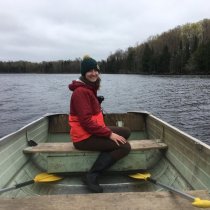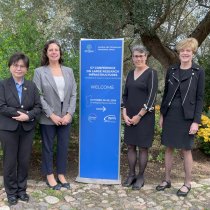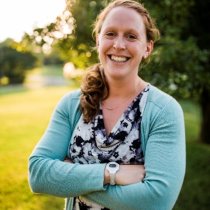Spotlight
Women in Ecology - Nyeema Harris
November 18, 2020
Ecology is truly global in nature — as an area of study so rich and variable, it requires researchers from all areas and backgrounds who harbor a real passion for exploration and knowledge-sharing across communities. To learn more about this perspective, we chatted with Dr. Nyeema Harris, Assistant Professor at the University of Michigan, about her work in conservation biology with lions and large carnivores, community ecology, urban ecology, and global change biology.
Dr. Harris discussed how her current work has given her the opportunity to share access to ecological study with more women and people of color. As we've seen throughout our Women in Ecology series, mentorship and proactive engagement are crucial for the diversification of students and researchers involved in STEM.
Q: What inspired you to become involved in your current research/field?
A lot of biologists have some type of transformative experience, especially scientists of color. We often don't have the same kind of experiences with nature as other people and so, for me, I went on a safari when I was 13 and I saw lions hunting. I was like, "Oh my goodness, this is National Geographic at its best." People were crying, I'm snapping pictures — and I decided, this is what I want to do with my life. Fast forward 20 years, I am now studying lions in West Africa, as one of my several current projects. So that was my entry into carnivore ecology in carnivore conservation.
Q: Please tell us a little about your career path.
When I was younger, I didn't know what a wildlife biologist was; I thought I had to be a zookeeper or a veterinarian if I wanted to work with animals. For my first job, I was employed at the Philadelphia Zoo. But then I realized that I could do research and study animals — not just make them healthy but think about them in their natural settings. So I majored in wildlife sciences as an undergrad, and that was my opening to this career path. As an undergrad at Virginia Tech, there weren't any examples or role models who were like me. I've worked for different agencies outside the academy, but why I chose academia now is to facilitate transformative experiences and create more representation in a space where we are often underrepresented — to create a space where our voices can be heard.
I was at an event in Detroit a few years ago and a little boy said to me that I didn't look like a biologist, and I said, "What am I supposed to look like?" Having "ologists" of color, women of color, and scientists of color doing these activities creates new conversations and opportunities. I feel very fortunate to be facilitating transformative experiences and exposing people to these experiences that can raise new questions and help people discover new dimensions of self.
Q: Who were your most important influences/mentors in ecological science?
My Ph.D. advisor, Rob Dunn at North Carolina State, was very thoughtful and conscious. He also instilled certain principles around public engagement, which resonated with me because he stressed that science should be open and not just produced by one demographic. He was/is a great model in helping me think about how we can facilitate programs and make sure there's a higher level of accessibility in scientific fields.
My undergraduate advisor and now colleague, Marcela Kelly, worked with big cats. I did a study abroad program in Belize to help on one of her projects, and it reinforced that this was the thing I loved doing. These two people were influential in guiding me, supporting me, and understanding that my journey would be unique, and that there were things I would have to troubleshoot because they wouldn't have experienced the same challenges as me.
Q: What challenges do women face getting into STEM fields? Have you experienced/overcome any of these?
One of the hardest things for me was not seeing representation in the positions I aspired towards for my career. And that reinforced doubts as to whether I belonged or was good enough for this. Then I matured and my confidence grew through experience and achievement, and I knew I that I couldn't let naysayers and opposers have such power over something I love and have an innate passion for. But it's difficult to define your professional identity in isolation when you don't have examples of people around you who are achieving what you want to do. I had to discover those things and navigate that myself. Having someone to talk to about it would have been great. But now, my contributions to the field extend beyond my work to affect how we work in my research program. For example, we sponsor students in Africa in the places where we work and aim to develop real partners through knowledge production and co-creation. My approach to science has become another extension of my contributions.
Q: How can research and educational institutions inspire more women to study fields in ecology, and also retain women who are early-career scientists to stay in ecology?
The system can be very hostile — it's not a comfortable environment. There are constant struggles, constant adversities, and constant biases that women and women of color face. As for retention strategies, mentors are great but that mentor isn't always in the meeting with you; they're not walking down the hallway with you. How do you show someone that they're appreciated and valued, and that their voice is heard? Certainly, there's a monetary aspect, and data does show that women are underpaid, so equalizing their salary is a minimum. But as we work harder, the diversity of our efforts should be elevated, rewarded, and compensated.
Women also contribute a lot in terms of volunteering, interviewing, mentoring, presenting, etc., but employers don't necessarily recognize or appreciate those efforts. So how do you demonstrate support? You could perhaps alleviate some responsibilities so that women and women of color have necessary administrative support, resources for graduate students and postdoctoral fellows, additional technological capacity and salary increases. All of these approaches demonstrate that we are heard and valued.
Q: What work are you most proud of at this point in your career?
Someone asked me before what my greatest achievement was, and they were probably expecting me to talk about an award I had won, but my response was Asia Murphy — she was the first student I mentored when I was a Ph.D. student. She's now working on her Ph.D. at Penn State, studying carnivores, and working with my undergraduate advisor. The fact that I was able to guide and mentor an African American female on a path she was passionate about has been one of the greatest rewards. And recognizing my impact in changing what my field looks like by introducing more people of color, and elevating and promoting them, has ended up being my greatest accomplishment to date. I didn't become a wildlife biologist because I'm a great people person or all about the warm and fuzzy, but the fact that I've had the opportunity to encourage and promote others that share parts of my identity has been really amazing.
Q: What do you hope to do in your field in the future?
There are two things: one is establishing a research center in West Africa. This is an area of the world with less scientific capacity, so being able to train students and have exchanges, in an interdisciplinary and culturally sensitive way that promotes global scholarship, would be a goal. The other is beginning a nonprofit that exposes communities of color to information about wildlife and the outdoors. I'm really interested in the opportunity to facilitate these transformative and authentic experiences, including research experiences in nature for communities of color that are underserved. So these are the two professional aspects that I'm most interested in.
Q: What is the most satisfying part of being an ecologist?
My job really fits my personality; I love being outside and in nature and the fact that someone pays me to go outside is fantastic. I'm also paid to talk to people about what I know, I get paid to write, I get paid to speak, and I'm able to recharge in nature spiritually and emotionally. Connecting with this natural side is a part of retaining my sanity and staying healthy. I also get to decide what questions I'm interested in, and I get to bring people along on this journey of knowledge production. There are layers of contribution too, and I get to define my own impact. I am never bored — there is too much to discover, uncover, and investigate!
As for the most challenging part of my job? The people! The reality is that not everyone wants me to be in this space and not everyone wants to see me succeed. I often feel like I have to work harder than others and having so many obstacles can get really difficult. Breaking boundaries and paving the way comes with a cost. There is a breaking point in retention where it's not worth that cost anymore.
Q: Tell us more about your work in animal ecology.
Lions are charismatic megafauna but, despite the world's interest, they are a species of conservation concern. With my research, I wanted to make sure there was an opportunity for transformation and to do science that leads ecologists and decision-makers to take action around the conservation of wild species. After lots of exploring and building relationships, I decided to develop a project and do this work in West Africa. This is not an area with a lot of scientific capacity, but there is a great need for science and researchers in this specific geography. Lions are considered critically endangered in West Africa, so there are chances for us to reverse that trajectory through collaborative research and community engagement. I've been working in West Africa for about six years, namely in Burkina Faso, understanding the threats they face in protected areas, their diseases, their diets, anything else that's a part of their story.
Q: What are some of the biggest threats? What patterns or solutions are you seeing?
I am optimistic that with increased attention and research there are opportunities to reverse these trends. We use camera traps as a survey technique and we expected to capture lots of poachers, but we didn't. Prey resources for lions and other large carnivores are depleting, and there's encroachment with livestock on these protected areas that can create conflict. That means there's a strategy that we can implement for intervention — maybe corridors can be identified for herders to move cattle along the park boundaries and not through the middle of the park. We've also started diet analysis from collected fecal samples to understand how much lions are relying on wild animals versus domestic animals, which is an important question in mitigating conflict.
Q: What is the most alarming discovery you have made?
I have not been alarmed yet, but some areas of research do need more attention. For example, we recently expanded our research into Senegal, where lions are also critically endangered coexisting with leopards and wild dogs which are also species of conservation concern and hyenas as dominant competitor. This vulnerable carnivore community adds complexities to research activities and management strategies. We've been wearing this lion hat for a while, but what is the capacity and needs of other carnivore species of conservation concern? We're studying their overlapping diets, their spatial overlap, and whether their threats are similar – we're starting to navigate all of that now.
Q: What is the most promising discovery you've made?
We've been doing work in the U.S. for around five years, looking at carnivores in cities and along rural-urban gradients and how they coexist with us. We've placed cameras in Detroit in 26 urban parks to study mammals and carnivores, and we have a public science website where the public is helping to identify animals. We have four sites across the state of Michigan, so there's a contrasting gradient of environments and conditions, and using coyotes as a focal species. Coyotes and other urban wildlife vary in their behavior, and we wanted to see and understand the mechanisms promoting such flexibility, so we're looking at their coexistence strategy with humans. For example, are they eating more trash or more small mammals, and are there any diseases and parasites they share with domestic dogs or cats?
We also take kids and community members into the field to explore their wildlife neighbors. It's important in my research group that we open science up to groups of all ages. My lab is called the Applied Wildlife Ecology lab, known as the AWE lab. We want to stimulate an appreciation and awe for exploration and wonders of the natural world. My philosophy with my students of all ages is to promote nature, whether they become an -ologist or not, and to think about how our decisions affect the world and wildlife around us.



